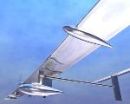



At its launch some 18 months ago, Solar Impulse was a dream, "now we have a real project," Piccard told journalists at the Paris Air Show here.
Piccard helped pull back a blue silk cover to reveal a scale model of the strange plane which, if other sponsors are found, should make its first flights in 2008 and, in 2010, go on a round-the-world mission.
It would promote a new era of aviation, in which planes would be clean, drawing on the almost infinite energy of the Sun rather than on the dirty, finite reserves of fossil fuels, he said.
"Sustainable development will not be achieved by stopping the mobility of the people," Piccard said.
The design comprises a frail-looking grey-painted craft somewhat similar to a military pilotless drone.
Its lanky wings measure some 80 meters (260 feet) across, equal in wingspan to that of the giant A380 Airbus that made its maiden public display at the Le Bourget air show...
In contrast, though, Solar Impulse will weigh just two tonnes, the size of a large car, compared with the A380’s 560 tonnes, and carry just a single passenger.
The power will come from 250 square meters (2,690 square feet) of solar panels on the wings’ upper surface. They will turn two engines, providing 40 horsepower of thrust — enough for a top speed of around 100 km per hour.
Batteries weighing 400 kg would take up surplus electricity generated during the day and at night time the plane would draw on this to help keep the engines going.
The battery reserves will not be enough by themselves. During the day, the aircraft will climb to around 10,000 meters (32,000 feet) and use this height to gradually glide down to 3,000 meters (9,750 feet) at night time.
Solar Impulse’s chief executive, Andre Borschberg, said a quarter of the estimated $40 million cost of developing the aircraft was now assured.
The Belgian plastics and pharmaceutical giant Solvay, the first of the project’s four "main partners", will provide expertise for the plane’s light but strong composite body.
Other partners in lesser roles include the French planemaker Dassault Aviation, whose aircraft designers will provide advice on aerodynamics; the French firm Altran Technologies, a specialist in solar-energy management and avionics; and the European Space Agency (ESA), which is making ground-breaking scientific discoveries available through its technology transfer programme for European firms.
If Solar Impulse lives up to Piccard’s and Jones’s vision, it could provide a technological leap forward for solar-powered aircraft.
These planes are in a similar situation to manpowered flight a century ago — they are just in their infancy and limited to short flights that are dependent on good weather.
The biggest problems are the relatively low efficiency of solar panels and the weight of batteries needed to store power. Investment in research may yield big gains in these areas and also smarter ways of husbanding the panels’ precious power.
Borschberg said the round-the-world trip would unfold over five legs, each of which would last "three to five days".
Sixty specialists have already been working on the scheme over the past 15 months.
Their computer simulations showed Solar Impulse should fly from west to east, between 10 and 30 degrees north of the Equator, to take advantage of prevailing winds and expected sunshine.
December 19, 2005
MORE (Flying Wing)
Richard Ingham,
TIMES OF OMAN
